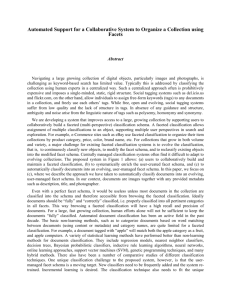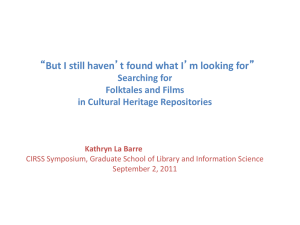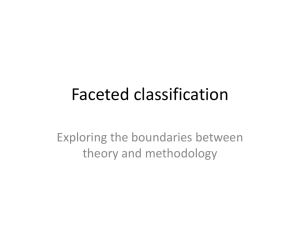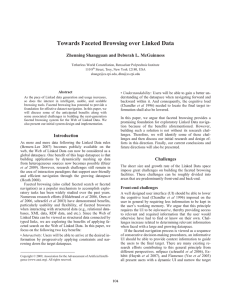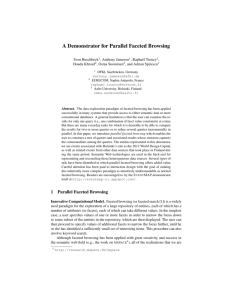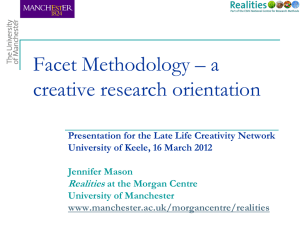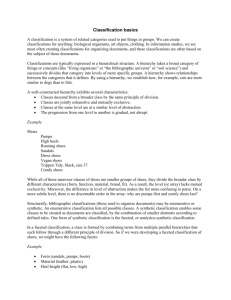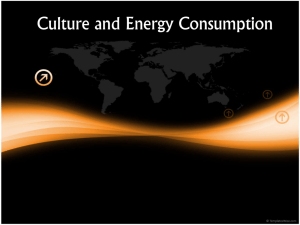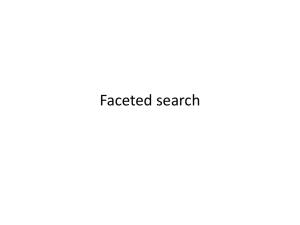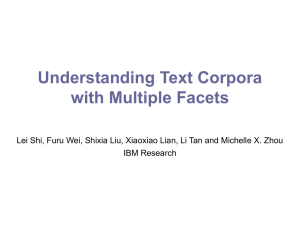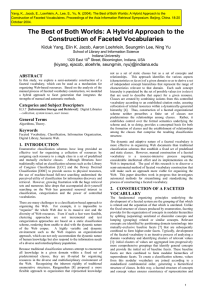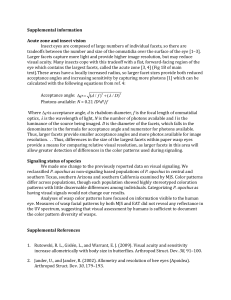ABSTRACT - ODU Computer Science
advertisement
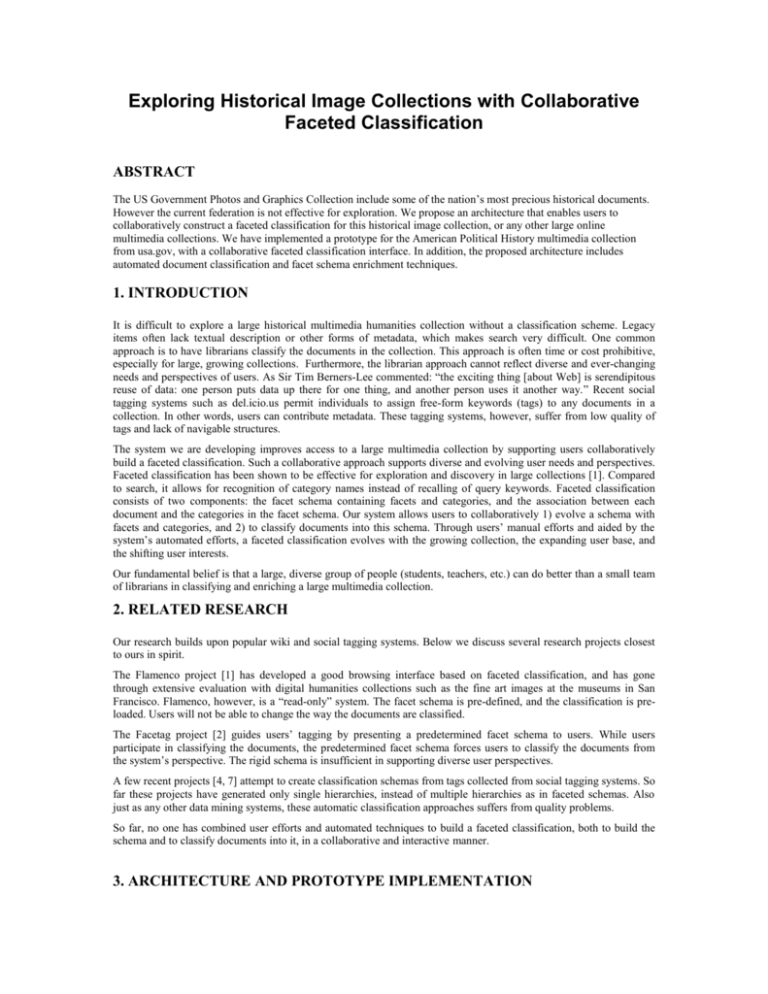
Exploring Historical Image Collections with Collaborative Faceted Classification ABSTRACT The US Government Photos and Graphics Collection include some of the nation’s most precious historical documents. However the current federation is not effective for exploration. We propose an architecture that enables users to collaboratively construct a faceted classification for this historical image collection, or any other large online multimedia collections. We have implemented a prototype for the American Political History multimedia collection from usa.gov, with a collaborative faceted classification interface. In addition, the proposed architecture includes automated document classification and facet schema enrichment techniques. 1. INTRODUCTION It is difficult to explore a large historical multimedia humanities collection without a classification scheme. Legacy items often lack textual description or other forms of metadata, which makes search very difficult. One common approach is to have librarians classify the documents in the collection. This approach is often time or cost prohibitive, especially for large, growing collections. Furthermore, the librarian approach cannot reflect diverse and ever-changing needs and perspectives of users. As Sir Tim Berners-Lee commented: “the exciting thing [about Web] is serendipitous reuse of data: one person puts data up there for one thing, and another person uses it another way.” Recent social tagging systems such as del.icio.us permit individuals to assign free-form keywords (tags) to any documents in a collection. In other words, users can contribute metadata. These tagging systems, however, suffer from low quality of tags and lack of navigable structures. The system we are developing improves access to a large multimedia collection by supporting users collaboratively build a faceted classification. Such a collaborative approach supports diverse and evolving user needs and perspectives. Faceted classification has been shown to be effective for exploration and discovery in large collections [1]. Compared to search, it allows for recognition of category names instead of recalling of query keywords. Faceted classification consists of two components: the facet schema containing facets and categories, and the association between each document and the categories in the facet schema. Our system allows users to collaboratively 1) evolve a schema with facets and categories, and 2) to classify documents into this schema. Through users’ manual efforts and aided by the system’s automated efforts, a faceted classification evolves with the growing collection, the expanding user base, and the shifting user interests. Our fundamental belief is that a large, diverse group of people (students, teachers, etc.) can do better than a small team of librarians in classifying and enriching a large multimedia collection. 2. RELATED RESEARCH Our research builds upon popular wiki and social tagging systems. Below we discuss several research projects closest to ours in spirit. The Flamenco project [1] has developed a good browsing interface based on faceted classification, and has gone through extensive evaluation with digital humanities collections such as the fine art images at the museums in San Francisco. Flamenco, however, is a “read-only” system. The facet schema is pre-defined, and the classification is preloaded. Users will not be able to change the way the documents are classified. The Facetag project [2] guides users’ tagging by presenting a predetermined facet schema to users. While users participate in classifying the documents, the predetermined facet schema forces users to classify the documents from the system’s perspective. The rigid schema is insufficient in supporting diverse user perspectives. A few recent projects [4, 7] attempt to create classification schemas from tags collected from social tagging systems. So far these projects have generated only single hierarchies, instead of multiple hierarchies as in faceted schemas. Also just as any other data mining systems, these automatic classification approaches suffers from quality problems. So far, no one has combined user efforts and automated techniques to build a faceted classification, both to build the schema and to classify documents into it, in a collaborative and interactive manner. 3. ARCHITECTURE AND PROTOTYPE IMPLEMENTATION The architecture of our system is shown in Figure 1. Users can not only tag (assign free-form keywords to) documents but also collaboratively build a faceted classification in a wiki fashion. Utilizing the metadata created by users’ tagging efforts and harvested from other sources, the system help improve the classification. We focus on three novel features: 1) to allow users collaboratively build and maintain a faceted classification, 2) to systematically enrich the user-created facet schema, 3) to automatically classify documents into the evolving facet schema. Figure 1. System Architecture We have developed a Web-based interface that allows users create and edit facets/categories similar to managing directories in the Microsoft File Explorer. Simply by clicking and dragging documents into faceted categories, users can classify (or re-classify) historic documents. All the files and documents are stored in a MySQL database. For automatic classification, we use a support vector machine method [5] utilizing users’ manual classification as training input. For systematic facet enrichment, we are exploring methods that create new faceted categories from free-form tags based on a statistical co-occurrence model [6] and also WordNet [8]. Note that the architecture has an open design so that it can be integrated with existing websites or content management systems. As such the system can be readily deployed to enrich existing digital humanity collections. We have deployed a prototype on the American Political History (APH) sub-collection (http://teachpol.tcnj.edu/amer_pol_hist) of the US Government Photos and Graphics Collection, a federated collection with millions of images (http://www.usa.gov/Topics/Graphics.shtml). The APH collection currently contains over 500 images, many of which are among the nation’s most valuable historical documents. On the usa.gov site, users can explore this collection only by two ways: either by era, such as 18th century and 19th century, or by special topics, such as “presidents” (Figure 2). There are only four special topics manually maintained by the collection administrator, which do not cover most items in the collection. This collection is poor with metadata and tools, which is common to many digital humanity collections that contain legacy items that have little pre-existing metadata, or lack resources for maintenance. Figure 2. American Political History Collection at usa.gov The prototype focused on the collaborative classification interface. After deploying our prototype, the collection has been collaboratively classified into categories along several facets. To prove the openness of system architecture, the prototype has been integrated with different existing systems. (Figure 3) The system integrated with a Flamenco-like Interface The system integrated with Joomla!, a popular content management system Figure 3. Multi-facet Browsing As users explore the system (such as by exploring faceted categories or through a keyword search), besides each item there is a “classify” button which leads to the classification interface. The classification interface shows the currently assigned categories in various facets for the selected item. It allows user to drag and drop an item into a new category. At this level user can also add or remove categories from a facet, or add or remove a facet. Faceted Classification button on the bottom of the screen (the button to the right links to a social tagging system, del.icio.us) The classification interface. Users can create/edit facets and categories, and drag items into categories Figure 4. Classification Interface 4. EVALUATION AND FUTURE STEPS Initial evaluation results in a controlled environment show great promise. The prototype was tested by university students interested in American political history. The collection was collaboratively categorized into facets such as Artifact (map, photo, etc.), Location, Year, and Topics (Buildings, Presidents, etc.) The prototype is found to be more effective than the original website in supporting user’s retrieval tasks, in terms of both recall and precision. At this time, our prototype does not have all the necessary support to be deployed on public Internet for a large number of users. For this we need to work on the concept of hardening a newly added category or facet. The key idea behind hardening is to accept a new category or facet only after reinforcement from multiple users. In absence of hardening support our system will be overwhelmed by the number of new facets and categories. We are also exploring automated document classification and facet schema enrichment techniques. We believe that collaborative faceted classification can improve access to many digital humanities collections. ACKNOWLEDGEMENTS This project is supported in part by the United States National Science Foundation, Award No. 0713290. REFERENCES [1] Hearst, M.A., Clustering versus Faceted Categories for Information Exploration. Communications of the ACM, 2006, 49(4). [2] Quintarelli, E., L. Rosati, and Resmini, A. Facetag: Integrating Bottom-up and Top-down Classification in a Social Tagging System. EuroIA 2006, Berlin. [3] Wu, H. and M.D. Gordon, Collaborative filing in a document repository. SIGIR 2004: p. 518-519 [4] Heymann, P. and Garcia-Molina, H., Collaborative Creation of Communal Hierarchical Taxonomies in Social Tagging Systems. Stanford Technical Report InfoLab 2006-10, 2006. [5] Joachims, T. Text categorization with support vector machines. In Proceedings of 10th European Conference on Machine Learning, pages 137–142, April 1998. [6] Sanderson, M. and B. Croft, Deriving concept hierarchies from text. SIGIR 1999: p. 206-213. [7] Schmitz and Patrick, Inducing Ontology from Flickr Tags. Workshop in Collaborative Web Tagging, 2006. [8] WordNet: An Electronic Lexical Database. Christiane Fellbaum (editor). 1998. The MIT Press, Cambridge, MA.
